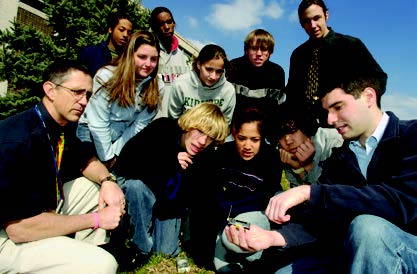
Grad student Sam Small deploys a remote sensing project at Poly to give high school students in-depth experience with environmental monitoring.
“GET STUDENTS INVOLVED in novel science, math, and technology experiences in the K-12 classroom, and they’ll be interested in studying engineering when they go to college,” explains Sam Small, a third-year PhD student in the Whiting School of Engineering’s Department of Computer Science. “Give them the chance to conduct research and understand its real-world applications, and they’ll be engaged and will want to do more.” That’s exactly his plan for students at Poly (Baltimore Polytechnic Institute).
When Small was a high school student in northern Virginia, he knew he wanted to study computer science in college. “I took an A.P. [Advanced Placement] computer science class and interned at technology companies while in high school,” he explains. At The College of William & Mary, he never questioned what his major would be—until the second semester of his senior year, when he took a biology class to fulfill a science requirement. “Until then, I never realized science and technology could be so closely related,” he says. “I think if I’d discovered that earlier, there’s a good chance I might not have majored in computer science—or I would have combined it with a science degree.”
This spring, through participating in BIGSTEP (Broader Impact for Graduate Students Transferring Engineering Principles), Small is combining his desire to share his interests—including the connections between computer science and biology—with his research. He is exploring wireless sensor networks with his adviser, Andreas Terzis, assistant professor of Computer Science. BIGSTEP, an initiative to reach K-12 students, is part of the Whiting School’s Center for Educational Outreach and is funded by the National Science Foundation. (See “One Giant Step Reaches Out to Schools” in the Fall 2005 Johns Hopkins Engineer.)
A Spring Planting of Sensors
On the grounds of Poly, a public high school known for its science and engineering curriculum, Small in March installed a network of 20 wireless environmental sensors. Students in Poly’s A.P. Environmental Science class helped deploy the sensors and will use them for research.
Poly’s wireless sensor system is similar to a network that Small, Terzis, and faculty from two Krieger School of Arts and Sciences departments (the Morton K. Blaustein Department of Earth and Planetary Sciences and the Henry A. Rowland Department of Physics and Astronomy) have deployed in the woods near the Homewood campus. “We’ve developed a network to monitor soil properties—moisture and temperature—using custom electronic components and software we’ve designed,” Small explains. “The data is collected automatically and is available to us on the web.”
Potential applications for this type of sensor are numerous, according to Small. They include structural monitoring that could provide an early warning system in unstable environments or environmental monitoring in numerous locations.
Analysis That Drives Inquiry
Traditionally, schoolyard ecology might involve a group of students monitoring soil temperature at one site, once a week, Small explains. The project at Poly, however, is unique in the sophistication of the tools the students are using and the depth of data they are gathering. The wireless sensors provide far more data—gathered from multiple locations and at multiple times. The data then are made available for analysis on the Internet through graphic simulations created by graduate students at California State University, Los Angeles.
This research opportunity, according to Small, provides high school students with far more than information about the ambient light levels, soil water pressure, and soil temperature in north Baltimore. “The project motivates science-based inquiry,” Small says. “When we’re dealing with data gathered at a finer granularity, it forces students to ask more questions and think about more nuanced topics than are usually introduced at the high school level—how to collect data, calibration, what is a ‘good’ measurement and what is not, and where bias might enter the picture. Analyzing the data provides real-world calculus problems for students to solve, bringing greater relevance and meaningful issues into their curriculum.”
Robert Marinelli, who teaches the A.P. class and heads Poly’s Science and Engineering Department, agrees. “This project gives kids the rare opportunity to do hard environmental science,” he explains. “Environmental science is usually observational at the high school level, but we’re generating real, quantifiable data.” Even more important, Marinelli states, is that, “Because of the way Sam has structured the class, asking the students what they want to study and giving them a say in the investigation, the kids are gaining experience as practicing scientists and they have real ownership of the project.”
Small’s work at Poly represents the first phase of a project that will eventually include California State University, Los Angeles; Tufts University; and Native American schools in Minnesota. This summer, Small will travel to Minnesota to help set up additional wireless sensor networks for high school students.
The remote sensing project, Small believes, could also help students better understand the connections between technology and science and could provide them with a broader range of options from which to choose when they begin college. “I think it can demonstrate to science students that there may be a place for them in technology,” he explains. “My hope is that the experience opens new doors for them.”




